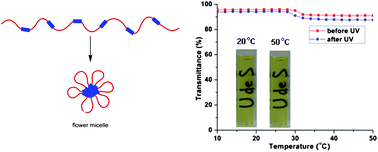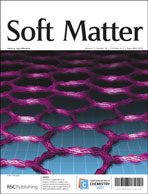Hydrophobically modified poly(N-isopropylacrylamide) (PNIPAM) with an azobenzene-containing short segment repeatedly inserted into the main chain was synthesized. The reversible trans–cisphotoisomerization of azobenzene was found to exert little effect on the lower critical solution temperature (LCST) or the cloud point of PNIPAM in aqueous solution. The characterization results of variable-temperature 1H NMR, TEM and DLS indicate the formation of flower micelles in cold water with hydrated PNIPAM. The segregation of azobenzene moieties in the micelle core from PNIPAM chains in micelle corona may explain the absence of an effect of photoisomerization of the chromophore on the LCST of PNIPAM. While the micelle core could react during the photoisomerization by swelling (with azobenzene in the cis form) or contracting (in the trans form) due to a polarity change, PNIPAM undergoes the hydration–dehydration transition according to its LCST. Another interesting finding is that the flower micelles resulting from this type of hydrophobically modified PNIPAM exhibit a much reduced propensity for inter-micellar association and could remain well dispersed at T > LCST of PNIAM, in sharp contrast with flower micelles formed by α,ω-telechelic PNIPAM. The multiple intrachain folding arising from this new PNIPAM structure appears to be the origin of the enhanced dispersion stability. With azobenzene groups stacked together forming the micelle core, the multiple loops for individual PNIPAM chains could reduce the number of inter-micellar bridge chains and restrict the chain entanglements upon dehydration of PNIPAM, which, consequently, reduce the propensity for micellar aggregation.

You have access to this article
 Please wait while we load your content...
Something went wrong. Try again?
Please wait while we load your content...
Something went wrong. Try again?


 Please wait while we load your content...
Please wait while we load your content...